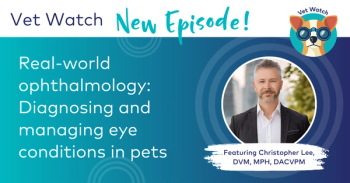
Management of tear film disorders in the dog and cat (Proceedings)
The precorneal tear film is a substantial structure both in its size and functional importance.
The precorneal tear film is a substantial structure both in its size and functional importance. Yet it's difficult to directly evaluate. Various studies have come up with imaging techniques to measure the thickness of the tear film and although one study measured it at a whopping 40um, essentially equaling the size of the epithelium, most still feel it sits somewhere around 10um.
It's easy to forget the magnitude of the tear film functions such as to nourish with O2, glucose, electrolytes; cleanse; lubricate; maintain corneal clarity; protect: immunoglobulins, enzymes, antibacterial, growth factors, and fibronectin. Alteration in any one or all of the above may lead to discomfort, infection, poor wound healing, visual abnormalities, and adjacent tissue dysfunction of the conjunctiva and eyelids.
Normal tear film distribution relies on 1. normal anatomy, 2. normal tear film quality, and 3. normal tear film quantity. The blink reflex relies on normal trigeminal nerve sensory interpretation to touching of the eyelid and the facial nerve motor ability to close the eyelids. Careful evaluation of all patients for the ability to blink is a rapid and critical test. Do not get in front of the eye as your hand will be visualized and you will be checking the menace response or vision. If pets have sensation but lack the ability to blink due to facial nerve dysfunction, they may actively pull the eyeball back with retrobulbar muscles CN VI, raise their third eyelids, and/or pull away when you tap them. However, lack of sensory innervation to cornea (V) decreases corneal health by limiting growth factors, nutrients, and immunoglobulins leading to a neurotrophic keratitis despite a normal STT and ability to blink.
Lagophthalmos is incomplete closure. Watch dogs in your exam room to see if they blink and ask owners to 'sneak up' on pets when sleeping to see if eyes are completely closed. Dogs such as Shih Tzus, Pugs, Boston Terriers with shallow orbits, prominent eyes with a lot of white scleral show, even with normal STT and reflexes often have incomplete coverage of their central corneas. The interpalpebral fissure epithelium may roughly pick up stain and often have an immediate tear film break up time (TFBUT)-normal is 20 seconds. We will discuss this later but essentially many of these dogs warrant attention to preventing central dryness. COMPLETION of the blink response is critical.
Small eyelid masses are often underestimated in their potential for irritation. Impaired sebum escape from underlying meibomian glands eventually leads to impaction, chalazion formation, and if rupture, severe, diffuse granulomatous blepharitis. Even small eyelid papillomas on older dogs that remain stable for years may cause significant eyelid margin trauma in these cases. Subtle problems with tear film distribution locally may lead to direct epithelial damage. Client education about possible problems is essential. Large marginal eyelid masses can be significantly interfering factors in normal tear film distribution. In addition, they may be malignant, destroy unique eyelid margin anatomy, and should be excised. Irritation to the cornea and conjunctiva may lead to pruritis and adjacent blepharitis.
Prolapsed nictitans glands should be repositioned for many reasons not the least of which is data clearly indicating an association with the development of KCS in the future particularly in the Bulldog, Cocker Spaniel, Cavalier, and Shih Tzu. The large, malpositioned gland itself, however, is a mass lesion that significantly affects normal tear film distribution, quality of its constituents, pH, bacteria, and mucous balance. The inflamed glandular tissue will eventually be replaced by nonfunctioning fibrous tissue and often significant bending of the associated cartilage. Surgical correction should be done early.
Trichiasis in the feline may be initiated by chronic feline herpes virus (FHV), trauma, and more rarely than in the dog, anatomy. Unresolved trichiasis often leads to a unique necrotic, brown corneal sequestrum. The cycle of keratitis, pain, enophthalmia, trichiasis, more pain, entropion, more blepharospasm, and erosion can be difficult to control in the cat without surgical intervention as the eyelids are so tight fitting.
Medial entropion is often something we see in the brachycephalic cats and yet the contribution of trichiasis to tear film abnormalities and epithelial damage is variable. Some cats with hairs touching the corneal tear film do sustain epithelial damage. It is not uncommon, however, for some cases to need medication and even surgical intervention in the long run. It is important to evaluate these pets with their eyes in different positions to determine if the hairs may have greater contact with the eye looking down, nasally, or laterally. In contrast, Pugs with medical trichiasis, often have a dramatic amount of pigmentation. As most of these pigmentary keratitis cases starting medially, it is assumed that the medial trichiasis with chronic epithelial irritation and abnormal tear film distribution initiate or significantly contribute to the pigmentation. Correction of the trichiasis intuitively makes sense to improve comfort and prevent continual damage. However, once the pigmentation process begins, even correction of the entropion may not lead to resolution of the altered pigment accumulation. This is important to convey to owners. I do find some improvement of pigmentation density as well as area with surgical repair, use of lubricants, tacrolimus or cyclosporine, and if vascularization is present, mild steroidal anti-inflammatories such as once daily hydrocortisone ointment with caution.
Macropalpebral fissure or elongation of the eyelids contributes to a combination of ectropion/entropion and lateral canthal instability. The determination as to whether or not to recommend surgery revolves around the degree of discomfort, damage, bilateral or unilateral, the age of the dog, and lastly, the desire to maintain cosmetics. If dogs are older than 4 or 5 and have lived comfortably with the eyelids and only recently are suffering from clinical signs often initiated by a trauma, a temporary tarsorrhaphy may alleviate the entropion. It is important to warn the owners that once sutures are removed, entropion may 'come back'. Keep the sutures in place as long as is needed to assure comfort with significant resolution of the corneal inflammation. Properly placed sutures (4-0 to 5-0 Prolene) may remain in place for weeks. Many young dogs with severely elongated eyelids and a combination of entropion/ectropion will need permanent surgical intervention. These can be tricky and I often use a combination of techniques. Although some of my colleagues recommend waiting until the large breed dogs with these problems such as St. Bernards are mature, I find that they do very well with correction at an early age and rarely if ever require second surgeries. Most owners are eager to resolve the problem. Some breeders, however, very much want to maintain the Diamond Eye look. Communication of expectations in these cases is critical. If owners are not willing to perform surgery, lubricating ointments, gels, or long contact time liquids are essential in maintaining a somewhat improved tear film integrity.
Tear Film Disorders also include the inability of the tears to flow properly out the nasolacrimal duct system. Epiphora may be due to 1. an increase in production such that it overwhelms the outflow system or 2. a decrease/blockage in outflow. Careful evaluation of the eyelid margins for the correct anatomic position, the presence of cilia emanating from the meibomian glands or conjunctiva as ectopic cilia, and the meibomian glands themselves may elucidate reasons for overproduction. Pain may also result from foreign bodies or inflammation. Diminished tear film stability may lead to a sensation of dryness/discomfort and therefore, lead to overproduction. In addition, if the trilaminar tear film constituents are not present, the tears may not bind to the cornea and just pool ventrally. The decrease in outflow may be due to a blocked duct due to a foreign body, mass effect, tooth root abscess. Or the tears may take the path of least resistance due to entropion, malposition of the eyelid margin, caruncle trichiasis, and eyelid notching. This list is not inclusive as once I found a worm as the culprit.
The Jones Test reveals abnormal passage down the nasolacrimal duct system. One drop is put in each eye at the same time, the dogs head is pointed to the floor, and the nares periodically examined. Most large breed dogs will have evidence at the distal nares in 15-30 seconds but time travel may be variable. The difference between the two will often be significant highlighting the affected side to determine if there is a blockage. Cats and brachycephalics may never flow distally if stain flows into the nasopharynx and the test may be nondiagnostic. If flushing is desired, some large dogs will allow it awake after multiple doses of topical anesthetic and a wait of at least 10-15 minutes. If a nasolacrimal cannula is not available, a 20-25g IV catheter sleeve will often work. Nonsterile water may be used in a 3cc syringe. Use magnification! Most small dogs and cats need to be sedated to accomplish a proper flush. While flushing from the lower duct, hold off the upper duct to force fluid down the nose and then alternate.
Small dog epiphora and tear staining is common and yet it is important to ascertain no pathology is present causing the abnormal drainage before it is ignored as 'normal for this breed'. Trichiasis from nasal folds or medial entropion commonly touches the tear lake and wicks tears down the face. The nasolacrimal duct system may in fact be present and flush well when a dog is under anesthesia as fluid is forced down the duct and yet when tears are forming in the medial canthus, they often take the path of least resistance. It's similar to a pool of water sitting on the table and you touch it with the edge of a paper towel. The water will wick up the towel just like the tears will be absorbed by adjacent hairs and flow down the face. Tears stain brown which is cosmetically unsightly but also underlying skin may be chronically wet and susceptible to moist dermatitis. A wet dog odor often ensues. Systemic antibiotics may decrease the bacterial load and the smell but may also in some cases reduce the brown staining. If Tetracycline (5mg/kg/d), metronidazole 100mg/d, or a 'pinch' of Tylosin are used, owners need to be cautioned as to the risk of long term systemic antibiotic usage and I again stress the need to evaluate for a specific cause of epiphora before using this mode of 'therapy'. Keeping hairs around the eye trimmed short may help.
The quality of the tear film in our education process has been largely ignored. This is in part due to a difficulty in being able to easily evaluate the constituents. We are all well aware of how to measure the water component with Schirmer's Tear Test strips and yet quantifying the mucin and sebum properties of the tear film are challenging. The Tear Film Break up Time [TFBUT] is used commonly in people to determine the tear film integrity and in fact the STT is often no longer considered as critical by many MD's. If you hear of people complaining about their 'dry eye', you may be surprised to see tears rolling down their cheeks. Yet their corneas feel bone dry. This is due to the inability of the tears to bind to the cornea, the water component 'falls' off the steep tissue, and leaves dry spots. The dry spots are what we look for in evaluating the TFBUT. Mucin binds water to the corneal epithelium and sebum prevents its evaporation. Although the mucin may be decreased congenitally, after chronic infections, from chemical burns, post radiation therapy, and some auto-immune mediated conditions, this is not known to be common in dogs and cats. Sebum deficiency, however, is very common.
Blepharitis, inflammation of the eyelid margins, and specifically meibomianitis, inflammation of the sebum producing meibomian glands, is commonplace in people and dogs alike. Although it occurs in cats, it appears to be less common. Sebum from these glands is normally an olive oil consistency creating an oil slick on top of the water to prevent evaporation. Infectious processes, endocrinopathies, immune mediated diseases, and/or, commonly, atopy, cause the sebum to become inspissated with altered polarity diminishing its binding ability to the underlying water. The sebum will no longer spread out as an oily surface layer and the water will rapidly evaporate. Dry spots form on the corneal epithelium which leads to tissue desiccation and the lipid oxidation may be directly toxic to the epithelial cells.
Blepharitis may be obvious if the margins are infected but the diagnosis of meibomianitis can be challenging. Evert the eyelid margins and look at the row of gland openings. Notice 'pointing' or swelling of the glands and a toothpaste consistency of the discharge if the eyelid margin is GENTLY squeezed. Pruritis is not uncommon and dogs may rub their face on the carpet or alongside furniture. Make sure you leave STT in for a full 60 seconds before you do this test as many of these dogs overproduce and will measure STT in the 30's. Abundant reflex tearing may compensate for the lack of tear conservation. The tear film breakup time takes practice to evaluate but once you see a film of fluorescein break up into the dry spots, it's easy to understand why the dogs feel dry and overtear to compensate. Place a drop of stain into one eye, make the eyelids blink, and then hold them open. Watch the film with a blue light and magnification. Start counting until you see a dark spot as the stain dissipates. Twenty seconds is normal and the rapid evaporation cases may be immediate. Do one eye at a time.
Once a diagnosis of meibomianitis is made or in conjunction with blepharitis, the primary etiology can be investigated. We see some cases in association with specific bacterial and or fungal disorders, immune mediated destruction of the eyelids margins and associated glands but many cases are likely atopy. Combined dermatologist investigation is often necessary to achieve control in these cases and prevent recurrences. Addressing the underlying issue is of course important. Treating the symptoms, however, is also important to improve comfort level and health. Cleansing is a critical component of marginal blepharitis therapy in people. I ask owners to use warm tap water and alternatively hold a face cloth against their dogs face. DILUTE Johnsons and Johnsons No Tears shampoo (1 drop on a 2x2 gauze square) is used by MD ophthalmologists for crusty eyelids. Systemic antibiotics are used in resistant cases and I find owners more willing to go this route than twice daily eyelid scrubs. Doxycycline at 5mg/kg BID for 3 weeks, decreasing to once daily or every other day will often improve the meibomianitis significantly. If these can only be maintained with pulse therapy then I assume atopy is the culprit and suggest further investigation. The goal is to manage these cases before the meibomian secretion becomes so firmly inspissated that it forms almost rock-like pearls under the conjunctiva. These may produce an irritating foreign body sensation, will likely never produce functional sebum, and may require surgery or cryotherapy to alleviate symptoms. It is important while doxycycline therapy is initiated, that the poor sebum quality is addressed. There are several products on the market that decrease tear film evaporation and I typically give the owners suggestions to find which one alleviates clinical signs of squinting, rubbing, epiphora in their pets. Tear lubricant ointments and gels are often of benefit although if atopy dogs are allergic to lamb, assure lanolin is not the ointment preparation. i- Drop and i-Drop Plus contain Hyaluronic Acid which binds to corneal and conjunctival receptors with prolonged contact time. Systane and Endura have oil and carbomers which help to bind the hydrophilic water layer to the hydrophobic corneal epithelium as well as delaying evaporation. Discuss with owners the need to keep their pets from hanging heads out the car window, sitting by air vents, being outside on windy days. Some severe cases exhibiting dryness also benefit from a humidifier. As with people, some are preservative sensitive and do better with the individual dose vials although these are more costly.
The quantity of the tear film affects different pets variably. Congenital KCS with tears 2-3mm/60sec may be minimally uncomfortable for months while an acute adult dry eye of 10mm/60sec may be squinting and rubbing. If cases have clinical signs and are less than 15mm/min, I treat them. Most cases do not show signs below 10mm. These should be placed on cyclosporine [CSA] or Tacrolimus right away. Do not just lubricate and wait for the tears to go lower as continued damage to the gland is occurring. Overall KCS incidence is approximately 1% and most are due to a mononuclear cell infiltrate with acinar atrophy although many other etiologies are present. These do not typically 'get cured' and client education to long term therapy is necessary. The tear stimulants may also require months to reach maximum affect during which time the STT may slowly rise. Lubricants, therefore, must be supplemented until recheck at 30 and 90 days. In cases under 10mm/60 sec and certainly those under 5mm/60sec I typically use the 1% cyclosporine rather than the 0.2% ointment. Cats typically have variable STT responses and I rarely use these numbers clinically unless there is a large discrepancy between them and the eye appears very dry. I often investigate the cause in the cat ie. chronic FHV, atopy, fungal and treat the cause and lubricate verses the use of CSA which is irritating and of minimal benefit in most. Although 82% respond to CSA, I do reach for Tacrolimus 0.2% in some cases due to its aqueous base. Severe meibomianitis likely has rancid fatty esters and I hesitate to add an oil based solution.
Newsletter
From exam room tips to practice management insights, get trusted veterinary news delivered straight to your inbox—subscribe to dvm360.






